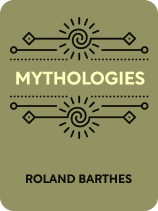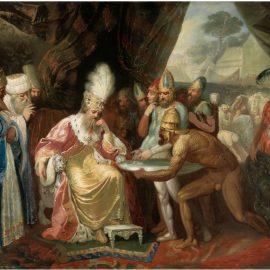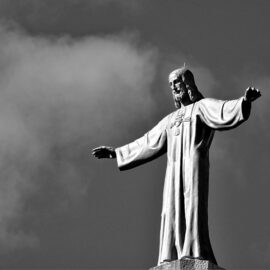

This article is an excerpt from the Shortform book guide to "Mythologies" by Roland Barthes. Shortform has the world's best summaries and analyses of books you should be reading.
Like this article? Sign up for a free trial here.
Is there a hidden message in the meme you just liked on social media? Is myth essentially propaganda?
According to Roland Barthes, myths occur when society’s dominant institutions imbue an image, object, or phrase with meaning. By forming these associations, the dominant social institutions create and reinforce cultural beliefs and values that are unconsciously adopted by the masses.
In Mythologies, Barthes aims to open our eyes to these manipulations and teach us how to avoid them. Here’s an overview of the book.
Overview of Mythologies by Barthes
In Mythologies, Barthes draws awareness to myths that are constantly around us. Think about all the images, messages, and stories you’re confronted with throughout the day. Open the newspaper in the morning, and you’ll see photos of wars, profiles of political candidates and entrepreneurs, and reports on the latest stock prices. Scroll through social media, and you’ll encounter a barrage of photos, videos, ads, and memes, all communicating some message. Go to the store, and products will catch your attention—consciously and subconsciously—with designs and slogans.
According to Roland Barthes, an influential 20th-century French philosopher and literary critic, these objects and images that we consume throughout the day are filled with myth. He says on a broad level, myth is a mode of communication—a myth conveys a message. Myths occur when society’s dominant institutions (for example, the government, the advertising industry, or Hollywood) imbue an image, object, or phrase with meaning. These meanings then serve to shape the way people in society view the world. By creating these associations, these dominant social institutions essentially create and reinforce cultural beliefs and values that are adopted unconsciously by the masses.
In Mythologies (originally published in 1957), Barthes analyzes a number of such myths from France in the 1950s. Part 1 of the book is a series of essays from a monthly column he wrote for the literary magazine Lettres Nouvelles between 1954 and 1956. Each essay discusses a myth from French society, exploring the nuance behind it and explaining how it conveys certain values. In Part 2, Barthes provides a more theoretical discussion of myth.
We’ll discuss Barthes’s theoretical framework behind myth and examine some of the examples he gives from 1950s French culture.
(Shortform note: The content of this book draws heavily from the social and political context of the time and place in which it was written, as well as being a product of Barthes’s political leanings. France in the 1950s had recently emerged from World War II and was in a time of rapid social change. The middle class was rising, and conservative political forces were promoting an anti-intellectual, populist, and anti-immigrant agenda in order to hold on to what they promoted as “traditional” values. Barthes was a progressive and a Marxist and was invested in calling out the propaganda he saw around him and raising awareness.)
Part 1: Understanding Myth
Before discussing where myth appears in society, let’s first define myth as Barthes presents it. Barthes explains that a myth is a message that’s conveyed when an object, image, or phrase becomes associated with a concept or value, and thus takes on a symbolic meaning. Myths shape the way we view the world and hold power over us when society’s dominant institutions craft these messages for us.
The Components of Myth: Form and Concept
Barthes argues that myths have two basic, interrelated components: a form and a concept. The form of a myth is concrete: It is the actual object, image, or phrase that we perceive with our senses. Barthes explains that, on their own, these materials have a literal meaning. However, the power of myth is that it imbues these things with additional meaning. Myth occurs when society connects the raw material of form to an abstract concept.
Barthes suggests also that myth doesn’t just add new meaning to the raw material—it also distorts the original meaning. While the original meanings do not disappear entirely, they recede into the secondary role of supporting the myth. According to Barthes, this receding of the form’s meaning is important because it allows myth to appear perfectly natural. In other words, it hides the fact that the relationship between the form and the concept is a construction.
The Creation and Function of Myth
Now that we understand what Barthes means by myth, we’ll turn to a discussion of how myths are created and utilized in society. According to Barthes, myth is essentially a means of culture creation. But, more specifically, he argues that it’s the creation of an “ideal culture” that obscures reality and diversity. Although Barthes doesn’t use the word, he’s essentially arguing that myth is propaganda.
He suggests that institutions in society create associations between certain signs and concepts, and the general population internalizes these associations and comes to see them as natural.
Barthes specifically aims to critique the class constructs that underlie the myth in his own culture (1950s France). He says myth is like a mask that presents a falsehood and shields people from harsh realities, which serves to sustain the social order and reinforce class distinctions.
The Dangers of Myth
Barthes suggests that a defining characteristic of myth is its ability to appear as “natural” even though it is constructed. This means that people don’t question the myth and instead accept it as fact.
Barthes argues that myth is both necessary and problematic. It’s necessary to some degree, he says, because it creates a simplified and comfortable world for people in the face of harsh realities.
Barthes points out that, when myth disguises the “dirt” of more serious issues like racism, sexism, or fascism, then we enter into dangerous territory, where people can come to accept these as natural and normal and fail to challenge them.
Barthes says that myth is the perfect vehicle for promoting political agendas. This has the dangerous implication that people can be manipulated into supporting social and political agendas that go against their own interests or values and uphold oppressive social structures.
Part 2: The Myths That Create Social Reality
Now that we understand what myths are and how they’re created, we’ll look at concrete examples of how myths are used to reinforce cultural norms and values. Since Mythologies includes 53 essays describing examples of myths Barthes collected from French magazines, we’ve identified the most common themes among them—namely, class, race, gender, and beauty constructs—and picked out one of Barthes’s examples to illustrate each theme. We’ll then illustrate the same concepts with contemporary examples.
Class Constructs: “The Blue Blood Cruise”
Barthes describes a news segment about members of European royalty taking a yacht cruise of the Greek islands in 1954. He takes issue with the media coverage of this event, which included minutiae about what they wore and when they woke up.
Barthes says the myth here lies in the presentation of royalty pretending to be regular people. But the deeper message conveyed by this spectacle is that they’re, by definition, not regular people. Otherwise, why would the reported details be newsworthy?
So, Barthes says, this kind of myth creates and reinforces notions of class distinction, and in fact deifies the nobility, presenting them as more than human.
Gender Constructs: “Novels and Children”
In his essay “Novels and Children,” Barthes explores gender inequality myths as he describes a segment from Elle magazine about women writers. In the article, a number of female writers are featured. e points out that the article spends as much time discussing the women’s roles as wives and mothers as it discusses their careers.
Barthes says that this article conveys the message that women are allowed to indulge themselves in careers only if they’ve also done their primary duty and had children. Barthes also points out here that the intended audience for this myth is not just women but men as well. He argues that this myth serves to reinforce and uphold a patriarchal structure in society, which is done most effectively when men and women buy into it.
Racial Constructs: “Bichon Among the Blacks”
In his essay “Bichon Among the Blacks,” Barthes describes a story from a French magazine called Match about a white couple who visited Africa with their toddler son, Bichon. The article, he says, places a heavy emphasis on the “courage” of the family. The myth presented here is a narrative about race, with the white couple being presented as heroic in their willingness to be among the “savage” Africans.
Barthes contends that the uneducated reader of an article like “Bichon Among the Blacks” wouldn’t have the ability to consciously detect the meaning—a subtle message of white supremacy—but that it would influence their perception of the world nonetheless.
Beauty Constructs: “Garbo’s Face”
Here Barthes analyzes the depiction of actress Greta Garbo’s face in film and photos. He points to lighting, makeup, and editing techniques meant to make her face appear perfect, without ever revealing a blemish or wrinkle. He says her face represents a cultural ideal of beauty, purity, and youth that is both unattainable and unforgettable.
Barthes calls Garbo’s face “an idea” in that it conveys a message about what he calls “amour courtois”—the concept of a noble and chivalrous kind of love. The population is meant to perceive her as something of a divine being, having a kind of beauty they should aspire to yet can never attain.
Again, we can see here the notion that the myth is both appealing and dangerous in the way it conceals the ugly truth of reality. Additionally, constructs of ideal beauty are the foundation of the beauty and cosmetic industry. The promotion of an unattainable ideal is the perfect setup for drawing people into buying cosmetic products and procedures.
Political Constructs: “Billy Graham at the Vel d’Hiv”
Barthes describes a televised event in which the American evangelist Billy Graham delivered sermons at the Vel d’Hiv stadium in Paris in 1955. Barthes views Graham as another version of a hypnotist or seance performer. Barthes goes as far as to argue that, “if God is really speaking through Dr. Graham’s mouth, it must be acknowledged that God is quite stupid.” It is, according to Barthes, the performance, not Graham’s message, which sways people. But the subtle message is there, and Barthes says that the message is anti-communist propaganda.
Barthes contends that Graham’s visit to France was clearly motivated by the American fear of atheism and the simplistic association of atheism with communism. Barthes says this kind of myth can cause masses of people to think illogically and fall prey to dangerous suggestions, and this can potentially have disastrous sociopolitical consequences. Of course, those consequences that Barthes would consider disastrous are exactly what’s intended by the myth creators—the powerful political elite—since this kind of myth, again, is designed to keep power structures intact.

———End of Preview———
Like what you just read? Read the rest of the world's best book summary and analysis of Roland Barthes's "Mythologies" at Shortform.
Here's what you'll find in our full Mythologies summary:
- The subtle messages that subconsciously shape the way we view the world
- How myths are used to reinforce cultural norms and values
- Why myths can pose dangers to society






